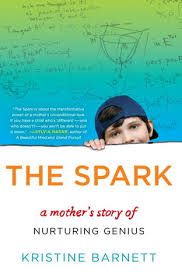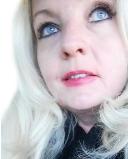Synesthesia
The Spark and Synesthesia
Savant Jake Barnett Calculates Using Colored Shapes
Posted May 17, 2013
Kristine Barnett knew it was in there somewhere-- there within a mind challenged by autism, was an undeniable spark in her son, Jacob.
Though "by age two and a half, Jake was a shadow of the little boy he'd been," she writes. "Most of the time, it didn't even feel as though he was in the room. He had stopped speaking entirely. He no longer made eye contact with anyone, nor did he respond when he was spoken to. If you hugged him, he'd push you away." However, he was able to draw at an early age. And he could do puzzles at lightning speed. He was obsessed with plaid fabric, shadows on the wall and circles.

So she fanned the spark she saw within him and took the emphasis off the shortfalls.
She took him out of special ed, which seemed to focus on what he couldn't do instead of the enormous talents he clearly had and began preparing him for mainstream kindergarten. He would surpass anyone's expectations and reveal great genius in math and physics in years to come thanks to his family's belief in him. Now 14, he is currently enrolled at Purdue for a Ph.D. in quantum physics.

The Spark by Kristine Barnett
In her new book, The Spark: A Mother's Story of Nurturing Genius,(Random House), Kristine Barnett describes how she surrounded Jake with what she calls "muchness"-- be it music, plaid fabric he loved, Q-tips to recreate maps of places they'd visited as a family-- just surrounded him with the things he loved, and drew him out.
The world is suddenly buzzing about Jacob Barnett. He has appeared on 60 Minutes. This is his TED talk:http://www.youtube.com/watch?v=Uq-FOOQ1TpE. The Huffington Post and the New York Daily News this week predicted he's in line for the Nobel Prize one day. But no one was really talking about Jacob's synesthesia. I'd noticed on the 60 Minutes report video of Jacob using colored squares of paper on a light box to do math. Though Morley Safer didn't identify the unusual method as synesthesia in his segment, I knew what Jake was doing, having my own colors for each number. How does this factor into his genius, I wanted to know.
I found the tireless Kristine willing to explore this aspect of Jacob's gift.
"Jacob has used his view of the world to "see" complex equations in math as many levels and dimensions of colorful shapes. By giving each number a color he can perform complex calculations in his mind also. I believe that layering the colors with the shapes (which are equations) he is able to manipulate the dimensions of space and time much in the same way we can twist an apple around in our hand and visualize the other side.
"He is able to spin them and project them onto surfaces. By his view of the world he became the world's youngest published researcher in physical review, A, the very journal Einstein was published in. He was also able to create his own theory at age 10 years old.
"I think that children with autism know that special place where math, art and music all converge. The way that they are able to look at the world if we really pay attention to them is extremely beautiful. One in ten children on the autism spectrum have savant skills. I think there could be very well be many more if we know what to look for.
"I would tell parents of any child to not be afraid to 'jump in' to their world. Do things with 'muchness'! To me this philosophy helped me very much in bringing out the colorful way that Jacob sees the world. I surrounded him and immersed him into the things that he loved and was drawn to as a child. I did not worry so much if they neatly lined up with any educational plan. I just set out to find what makes him truly happy and to do those things with him. Doing this gave me a peak into his mind and what I saw there was spectacular!
"I took him out in the soft Spring grass under the stars and danced to jazz music. We ate popsicles and blew dandelion fluff at each other. We built sandcastles in the backyard in the moonlight. These things were my effort to give him back his childhood from a very packed therapy schedule that was primarily focused on things that challenged him. But in the end, quite unexpectedly, the stars were the bridge that brought Jacob back from autism and into my world. Jacob became obsessed with the stars and planetariums. I used to think of the stars as somewhat boring and really did not get his intense interest in them until one day I asked him what he saw in those far away little lights. He immediately took me to a computer and pulled up a picture of a nebula. It was the most beautiful thing I had ever seen. It was then I understood how his mind's eye looks at the world, with math and art combining and with wonder.
"I had no idea what synesthesia was and honestly still really am not that informed. It seems it is very rare. However I am certain my sister who was a child art prodigy has synesthesia.
"When I first heard that he was doing this was when he was explaining it to students he was tutoring. I could not help but notice he was teaching math in an entirely new way! We were told about synesthesia by Joanne Rithsatz at Colorado State.
"I would say that there I have always seen the things Jacob has done as strikingly marvelous in their color and complexity but had no name for it. I think prodigy in fact, may be under found or under diagnosed because if Jacob did not have autism I would not have realized it, but in with all of his challenges he was being assessed more than usual.
"We need to be looking for the gifts and talent in our children."
The Barnett family lives in Indiana. In 1996 Kristine founded a daycare center called Acorn Hill Academy and she and her husband Michael also founded a community center for autistic and special-needs children and their families called Jacob's Place.
"If a child who was never supposed to talk or read can rise to such improbable heights, imagine what children without such challenges might achieve, and how far they might soar if we encouraged them to unfurl their wings--past any horizon, past even our wildest expectations," Kristine closes in her fascinating book. "By sharing our story, I hope that will happen."




